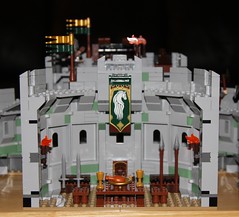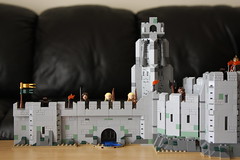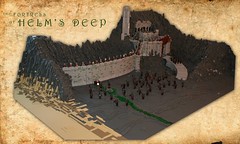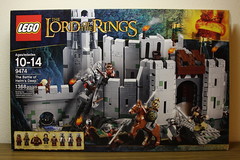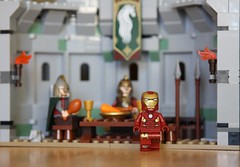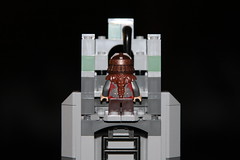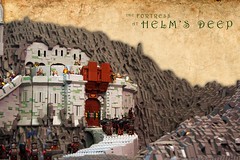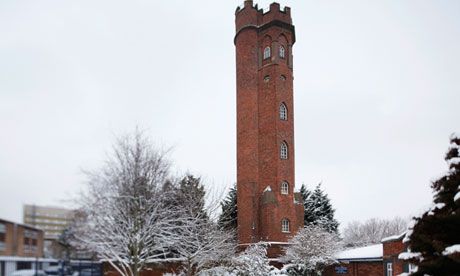You’ve probably heard of J.R.R. Tolkien and Peter Jackson. You might think they’re the reason we can all enjoy The Hobbitand Lord of the Rings books and movies. Well… okay, they are. But you might not know how close you were to never being able to enjoy the adventures of Bilbo and Frodo in the way you know them, save for some other amazing factors. What am I talking about, you ask? Well hang on to your magic rings; it’s time to look at nine mind-blowing reasons we are able to enjoy Tolkien’s books and Jackson’s movies.
#1: A 10-Year-Old’s Book Report
Today there are many different options for writers searching for a way to share their work with readers. You can self-publish, write an e-book, post something on a website, etc. (You could even be a dinosaur like me and actually go through a publisher.) Back in the 1930s, however, Tolkien had only one real avenue to share The Hobbit with a wide audience: George Allen & Unwin, a publishing firm. One of Tolkien’s students had recommended the story to a friend who worked there, and the firm took a look at the manuscript. When I say they “took a look”, you’re probably thinking that some English literature expert carefully examined the work before reporting to a committee for a discussion and a decision. But actually what I mean is, “One of the guys gave the manuscript to his 10-year-old son and told him to write a book report on it.”
That’s right. The Hobbit – and by extension The Lord of the Rings, all the movies, and the distribution of billions dollars – ultimately had their fate decided by a 10-year-old (Rayner Unwin) and his pencil. Now, I don’t know if you have children, but my wife’s a schoolteacher, and according to some of her students’ book reports, The Hobbit is about “Bible the hobo who chases dragonflies.” Thankfully, Rayner did a better job, although the heck of it is he wasn’t overly impressed with Tolkien’s work. The 10-year-old gave The Hobbit a backhanded compliment, saying it “should appeal to all children between the ages of 5 to 9.” His praise, however, was enough for his father, and the book was published.
Rayner’s importance doesn’t end there. In 1951, he began working for Allen & Unwin as an adult, and one of his first tasks was deciding what to do with Tolkien’s next manuscript, The Lord of the Rings. Upon reading that one, he had two thoughts: first, it was a work of genius, and second, it was going to cost more to publish than the firm would ever make on its sales. He published anyway. (Aren’t you glad he did?)
#2: Fritz the Cat (1972)
Based on the comic strip of the same name, Fritz the Cat was an X rated animated film directed by Ralph Bakshi, When the film ran into financial trouble, Bakshi convinced a record producer named Saul Zaentz to invest in the project in exchange for the rights to distribute the soundtrack. The movie (released well before anime overexposed the idea of naughty cartoons) went on to become a box office sensation and made Zaentz a fortune.
Flash forward a few years: Bakshi is working on a film adaptation of The Lord of the Rings for MGM when there’s a change in executives, and the new guy wants to kill the project. Who does Bakshi ask to help bail him out? Saul Zaentz, who had begun to dabble in films. At the invitation of Bakshi, Zaentz acquired most of the rights for The Hobbit and The Lord of the Rings, and produced Bakshi’s animated Lord of the Rings.
I can hear it now. “Okay, Bakshi and Zaentz made a crappy Lord of the Rings film. Big deal! Maybe it would have better had there been no Fritz the Cat then.”
Calm down, Chief. There’s more.
To begin with, the animated adaptation of The Lord of the Rings is significant for introducing a certain 17 year old Kiwi to the wonders of Middle-earth. Sitting in his seat at the Wellington Plaza, Peter Jackson was so fascinated by what he saw he ran out and bought the book with the movie’s tie-in cover art. You can argue that even had he not seen the film, he might have read the books and become a fan anyway, but consider this: Jackson isn’t one of those Tolkien-obsessed fans who grew up reading the books over and over. He saw the Bakshi film, read the books once, and that was it… until he became interested in making his own film adaptations.
But there’s also this: Zaentz never sold the rights and still holds them today – having recently celebrated his 157th birthday. This is an important point, because you have to understand that most people in the industry do not act like Zaentz (who is slightly looney and once sued John Fogerty for plagiarizing himself.) For Zaentz, making movies has been more of a hobby than a business. Since 1972 he’s produced ten of them – with three winning the Oscar for Best Picture. Had the rights to The Hobbit and The Lord of the Rings been in other hands, it’s likely we would have seen a far different “Tolkien movie” history. Would we still have Hobbit and LOTR films? Sure. We’d probably have more of them, with some studio doing a reboot of the franchise every few years like The Incredible Hulk or Star Trek. We might even have some lousy TV movies mixed in there as well. (Maybe even a Saturday morning cartoon show called “LOTR Kids” about the nine fellowship members sharing adventures together as children and overcoming the bullying of kiddy Sauron.)
I for one am happy that instead of countless crappy adaptations, we got nothing for twenty years and then were given three blockbuster Lord of the Rings feature films. So let’s give Fritz some thanks, even if he gives us the finger in return.
#3: The English Patient (1996)
You’re probably familiar with the movie The English Patient. It’s that 90s film starring Lord Voldemort that won a bunch of Oscars. What you might not know is that without the movie we probably wouldn’t have The Lord of the Rings movies (which did not star Lord Voldemort but did win a bunch of Oscars.)
The English Patient was produced by a guy named Saul Zaentz and was supposed to be made for Twentieth Century Fox, the studio footing the bill. Fox, however, backed out at the last minute, and Zaentz was left with a cast and crew in Italy and no money to shoot the movie. Almost immediately, however, Harvey Weinstein stepped in and acquired the project for his studio, Miramax (named after his parents, Mira and Max) and saved the day. Zaentz was grateful and promised to return the favor if ever an opportunity presented itself.
Meanwhile, a pair of filmmakers named Peter Jackson and Fran Walsh were working on post production for The Frighteners(1996). Jackson suggested the two might want to do a fantasy film next, and Walsh asked if it were possible to do The Lord of the Rings. Jackson assumed the rights were unavailable or tied up, but he figured it wouldn’t hurt to ask – so he went to the studio he was working with and said, “Hey, do you think Fran and I could make The Lord of the Rings?” That studio was Miramax, and the guy he was talking to was Harvey Weinstein, who loved the idea. Weinstein contacted Zaentz and called in his favor to get an option to make the movies, and Jackson was on his way to making Middle-earth magic.
#4: Ken Kamins’s Ingenuity
It’s 1998. (It’s not, but pretend it is.) Peter Jackson is summoned to a meeting with Miramax in New York. The studio has a great new idea: it’s going to make The Lord of the Rings as one film. They have a whole new approach to the story: The Mines of Moria? Skip them. Saruman? Gone. The Battle at Helm’s Deep? Gone. Gondor and Rohan? Merge them and make Boromir and Éowyn brother and sister. Maybe kill off some redundant hobbits.
I do have to mention here that Miramax wasn’t intentionally trying to be stupid. The problem was the budget. They had $75 million to spend on The Lord of the Rings and that was it. Given the choice between two low budget films or one with a modest budget, they chose the latter under the premise that it was most likely to make money. (After all, there’s a reason the film industry is called an industry and not “charitable contributions to the arts.”)
Jackson, of course, was horrified and said he couldn’t write and direct what they were proposing. Miramax, however, held firm and said, “Take it or leave it.” Jackson and Walsh talked about the ultimatum privately and then decided to say no and move on to other things. They asked their agent to tell Miramax they were out, and they figured that was that.
Jackson’s agent was Ken Kamins, and he did make the call, but with a wrinkle: he reminded them that this whole project began with Jackson and Walsh and asked if the two writers could find another studio to buyout the project and do it the right way. And that’s exactly what happened. In fact, that leads us to…
#5: Jim Carrey
That all changed in 1994 when he was transformed into a bankable Hollywood star thanks to Ace Ventura: Pet Detective, Dumb and Dumber, and The Mask. The latter two were brought to us by New Line Cinema. This maverick studio was great at finding new stars and making and distributing hits; they just had trouble with sequels. Remember how funny Carrey was in “Dumb and Dumber 2” and “Revenge of the Mask”? Of course you don’t! Because he wouldn’t do them. Instead he went on to make big money for other studios. So we got new actors in Dumb and Dumberer and Son of the Mask – which, quite frankly, were terrible. Back in 1998, New Line executives were concerned about this problem, and one of the execs joked that they should just start shooting sequels to their blockbusters before they were finished shooting the blockbusters.
At just about this time, New Line was contacted by a guy named Peter Jackson. He said he had this Lord of the Rings project he was working on and was wondering if New Line would be interested in acquiring it from Miramax. “They’re only willing to make one film out of it,” he explained, “but we feel the only way to do it right is to do two films at once.”
New Line: “Two? Just two? Why not three?”
Jackson: “As I was saying, three films. We feel the only way to do it is three films.”
Christian Rivers: “Isn’t it a little late in the process to…”
Jackson: “To find myself a new Beacon keeper? No.”
Rivers: (silence)
What New Line Cinema didn’t know was had they turned Jackson down, Miramax was ready to fire Peter Jackson, replace him with John Madden, and make the one film version described above.
Thank you, Jim Carrey. Thank you.
#6: Sean Connery’s Confusion
Think about all the scenes in The Lord of the Rings and Hobbit movies with Gandalf. Now think of all of them without Ian McKellen and with Sean Connery in his place.
“Shauron is coming for the Ring, my boy. Keep it shecret, keep it shafe.”
(That’s my Sean Connery impression. Thank you, I’m here all week! Try the veal.)
Connery turned down the part because he didn’t understand the script. Years later, he reflected upon the story after reading the books and seeing the films: “”I read the book. I saw the movie. I still don’t understand it.”
He did add something that we can all agree upon: “Ian McKellen, I believe, is marvelous in it.”
#7: Harry Knowles
It’s easy to sit at home on the couch and fantasy-cast movies. “Dude, they should make a movie out of that “Smoking Cactus” book and cast Sam Elliott as the Texas Fryfish.” Heck, I’ve fantasized about the girls from Happy Hobbit playing damsels in distress, whereupon I rescue them and they begin fighting over me. But perhaps that’s taking the “fantasy” in fantasy-casting too literally. The point is, it’s fun to match up actors and characters. But how many times have you approached the actor and told him about the character… and then approached the director and told him about the actor?
In 1998, supergeek Harry Knowles had a cameo in the movie “The Faculty”. Here’s what happened in Harry’s own words:
“I remember, I was sitting on the steps of THE FACULTY’s set where Elijah [Wood] is going to be running from Robert Patrick. There was a break in shooting, because as Robert was running with the steadi-cam, he slipped and fell and they were checking all the equipment out. Elijah joined me on the steps and asked how things were going. It was mid-afternoon and I told him that I had spoken on the phone with Peter Jackson that day. That Peter was going to try and make THE LORD OF THE RINGS. Elijah had never read that book, but he had read the Hobbit, and loved that. That’s when I looked at him and told him he would be perfect to play Frodo.”
Wood, of course, then went on to make his own audition tape in his own makeshift Hobbit costume.
Meanwhile, Harry went on to have more discussions with Peter Jackson, including Q&A’s which he shared on his website. Jackson told Harry about his plans: he was going to cast an unknown British actor as Frodo. Harry had an idea of his own and said so: cast Elijah Wood!
Maybe Wood would have been cast as Frodo without Harry’s heads up or help. Either way, Harry’s championing of Wood as Frodo – going all the way back to 1998 – gives him plenty of Geek-Cred in my eyes. (I actually had a shirt once that said, “I have Geek-Cred.” Unfortunately, my wife accidentally spilled something on it. The gasoline probably would have come out in the wash, but my wife also accidentally set it on fire. But I digress.)
Then again, perhaps the real hero of the story is Robert Patrick’s clumsiness. Who knows? Had he kept his footing, the butterfly effect might have led to Dustin Diamond playing Frodo. And that’s even scarier than being chased by a Terminator.
#8: Jar Jar Binks
Yousa probably wondering if mesa gone coo coo here. (Happened long ago.) Sure, on the list of “Reasons Star Wars Rocks,” Jar Jar ranks at roughly 4,285,433 – just ahead of Princess Leia’s Life Day song.
But here’s the thing: while the people working on The Lord of the Rings were having all kinds of trouble with Gollum, George Lucas was busy making dozens of breakthroughs in CGI to bring Jar Jar to the screen. Jackson decided from the beginning that Gollum would be CGI, but by 1999 it was beginning to look like the impossible dream. Thankfully, Lucas was happy to help out Weta, and thanks to Jar Jar breaking new ground, Gollum did not end up as a man in a suit.
#9: Gray Horsfield
Quick question: who defeated Sauron? Was it Frodo? Aragorn? Gandalf? No, it was Gray Horsfield, a real name that’s so awesome, no fiction writer would have the cojones to use it.
Back in the early part of the last decade when Weta was working on the final Lord of the Rings film, they were in a jam: they needed to show the destruction of Sauron’s tower (Barad-dûr) but it wasn’t physically possible to blow up the model, and it probably wouldn’t give them the look they were hoping for anyway. At this point most films would have gotten together a team of digital artists and given them a month to work on doing it CGI. Weta didn’t need a team, however, because one guy did it himself. In two weeks. While everyone was on vacation. Gray Horsfield basically worked 20 hours a day everyday while everyone was on break blowing up Barad-dûr and blowing away everyone from Weta Digital when they returned to work. Frodo may have failed, but Gray sure didn’t.
So there you go. From a ten year old’s book report to Gray Horsfield’s dedication, that’s nine pieces of the puzzle that fell into place to give us some great books and movies. Doesn’t it make you feel like you won the lottery and didn’t even know it?
(I can’t believe you actually read this whole thing.)
- J.W. Braun
